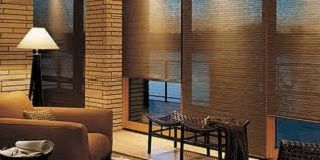From a Guest Blogger: Motorized Blinds Are Greener than the World Thinks

Let’s start with an introduction to motorized blinds. They were once the product that were designed for either the filthy rich, or those windows that were just inaccessible. Now, the landscape is changing and it’s not even that uncommon to see these systems installed on most of the main windows of a home – accessible or not.
The reason is simple – motorized blinds can aid with a green lifestyle.
First and foremost, we should note that some of these systems don’t even rely on electricity. Some companies have developed devices that use solar power to function, meaning that they are the definition of a green problem. However, we’re not going to suggest for a moment that this is the only reason they are green – that would be the coward’s way out, so to speak.
Instead, we’re going to focus on a feature that has been implemented into these systems over the last few years. That feature is a programmable timer and on that note, any green enthusiast should sit up and take notice right now. The programmable timer is the key to an eco-friendly house. We’ve been told for years how blinds can have a positive impact on the overall temperature of our home. In warmer climates, they can prevent the sun penetrating into a room and subsequently reduce the reliance on air conditioning systems. In cold climates, they can prevent heat from escaping from a room and again reduce the pressure on a boiler.
So, it’s all about setting that programmable timer to function at appropriate times of the day. In the case of the summer months, or if you are lucky enough to reside in a hot region of the country, your aim should be to draw the blinds at the peak sunlight areas of the day. Obviously, this is going to vary depending on the orientation of your room. If you are concerned about limiting the natural light during the middle of the day, consider something like a solar shade to at least allow some to go through your glazing.
Then, in the winter, it’s time to act a little differently. Rather than avoiding the sun, you’ll need to ensure that the blinds are fully open when it does decide to make an appearance. Again, timing is everything here, so finding out the most likely time for sun to gaze through is key to at least supplying your room with a little heat. The most important tip comes when you set the timer to close the blinds though; with this correlating with the evening so that you can prevent as much heat as possible from escaping when night does fall.
If you can follow such suggestions with a motorized blind, you will have quickly reduced a lot of reliance on your heating or cooling system and immediately made your home greener. Now can you understand the potential eco-friendly benefits to these systems?

The equipment that I program is capable of adjusting the lights and shades and HVAC daily based on sensor readings, astronomical clock and your position on the face of the planet.
I still contend that while shades will provide useful insulation in the wintertime, in summer if you want to keep the sun out it needs to be done with something outside if the window. Greenhouse effect occurs when sunlight passes through glass and the sunlight is altered due to passing through the glass. Once the energy is inside the glass it doesn’t matter what it strikes. The heat is in. That is the operating principal of solar air heaters as well. If you want to stop solar heat from entering the building you need to stop it outside of the windows with some type of external shutters.